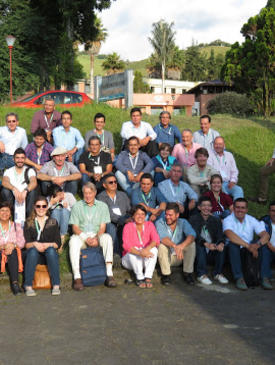Ecological Restoration of Cattle Ranching Farms (pre-congress course)
Summary
Conventional cattle ranching poses a great challenge for ecological restoration because it currently occupies more than 600 million hectares in Latin America, and has been a driver of deforestation, land degradation and the loss of water resources. However, ranching also provides a huge opportunity for landscape-scale restoration in the region, for different reasons. On the one hand, recent extreme climatic events have led the livestock sector to question the viability of extensive grazing in conventional grass monocultures. This means that cattle ranchers, extension agents and decision makers are more willing to incorporate shade trees in pasturelands. On the other hand, there is a growing demand for livestock products from sustainable systems, and an increasing awareness of the ecosystem services provided by cattle-dominated landscapes and farms. Throughout the region, silvopastoral systems that combine grasses with native trees and shrubs, are being acknowledged as a sustainable method for increasing the profitability of milk, meat and timber production while enhancing environmental services and biodiversity conservation in rural landscapes.
The talks and discussions of this pre-congress course focused on different aspects of the transformation of conventional livestock systems into silvopastoral systems (SSP), and the complementary restoration activities that must be done to secure water resources and biodiversity conservation. The course explained different land rehabilitation and restoration strategies that can be applied in cattle ranches to improve landscape connectivity while providing a shaded habitat for the cattle, a wildlife-friendly agricultural matrix and healthy riparian buffers. Several case studies illustrated ecological rehabilitation and restoration results at different scales.
Content
Objectives: This one-day course was offered free of charge to all participants registered in the 9th International Congress on Silvopastoral Systems (http://silvopastoril2017.org/), which took place on September 6-8, 2017, in Manizales, Colombia. The course included four lectures on ecological restoration, recovery of eroded lands and participatory farm planning for sustainable cattle ranching. Case studies were presented of conventional cattle ranches undergoing restoration of riparian forests, gullies and landslides in different regions of Colombia.
Field-course format: The course began with a presentation of the participants and the agenda. In the first talk, Zoraida Calle introduced the principles and challenges of ecological restoration in cattle-dominated landscapes and at the scale of individual farms. This talk discussed how the transformation of conventional cattle ranching into silvopastoral systems enhances environmental services while increasing the productivity and profitability of the farming system, and at the same time allows for the release of marginal and fragile lands for ecological restoration.
In the second talk, CIPAV researcher and ELTI alumnus Mauricio Carvajal discussed restoration in lands affected by severe erosion. He explained how conventional management practices can cause laminar erosion and the formation of gullies in livestock systems. Appropriate soil conservation and restoration practices were illustrated through four examples of restoration projects that included a diagnosis and restoration plan involving assisted natural regeneration, biomechanical structures and enrichment planting. These first two talks were followed by questions and a general discussion, in which participants from different countries highlighted differences and similarities between the Colombian examples and their own experiences.
After lunch, CIPAV researcher and ELTI alumnus Julián Giraldo explained the method of participatory farm planning, which facilitates the productive transformation and the ecological restoration of cattle farms. Julián showed the basic principles that guide the re-design of conventional farms to enhance production while conserving forests and restoring riparian buffers, steep lands and connectivity corridors. In the next talk, Alicia Calle showed four case studies of contrasting cattle farms that have been undergoing restoration during the last 13 years. The detailed land use change and tree cover data illustrated the biophysical transformation of the cattle farms, and the changing values of their landowners.
In the last talk, Zoraida Calle presented about ELTI and the Leadership Program. The course ended with a general discussion and a written course evaluation.
Participants: This field course was announced in the webpage of the 9th International Congress on Silvopastoral Systems (http://silvopastoril2017.org/). All congress participants that registered online were selected to attend. The 45 course participants represented farmers, non-government organizations and academia from Colombia, Peru, Paraguay, Uruguay, Argentina, Honduras, Mexico and the UK.
Instructors
• Zoraida Calle, ELTI (Colombia Program Coordinator) and CIPAV, Colombia
• Mauricio Carvajal, CIPAV (ELTI alumnus), Colombia
• Julián Andrés Giraldo, CIPAV (ELTI alumnus), Colombia
• Alicia Calle, University of California (Santa Cruz)
Outcomes and Follow-up: Course participants showed great motivation during all lectures and group discussions. The diverse perspectives and experiences from farmers and professionals of tropical, subtropical and temperate countries enriched the dialogue between sustainable cattle ranching and restoration. Participants rated the course with an average of 4.76 (out of 5).


